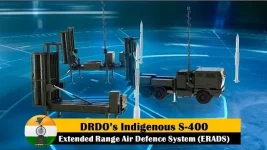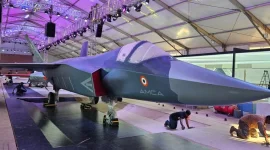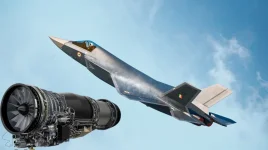- Views: 396
- Replies: 4
In a significant advancement for India's aerial warfare capabilities, future pilots of the Advanced Medium Combat Aircraft (AMCA) will be equipped to command swarms of stealthy "loyal wingman" drones, known as the Combat Air Teaming System (CATS) Warrior.
This development is poised to enable the Indian Air Force (IAF) to conduct perilous missions aimed at suppressing or destroying enemy air defences without directly endangering pilots or expensive manned fighter jets.
Modern warfare increasingly hinges on the capacity to overcome sophisticated enemy air defence networks. As potential adversaries field advanced systems, including long-range surface-to-air missiles (SAMs) and comprehensive radar grids, the necessity for aircraft that can breach these defences to strike critical ground targets while minimising risks to valuable aerial assets has grown critical.
India’s Defence Research and Development Organisation (DRDO), working alongside Hindustan Aeronautics Limited (HAL), is spearheading the CATS Warrior program to meet this evolving challenge. This unmanned aerial vehicle is designed to operate in conjunction with advanced manned aircraft like the AMCA.
The CATS Warrior is viewed not merely as an enhancement to existing forces but as a transformative approach for India to counter enemy air defences efficiently and with reduced risk.
Contemporary air defence systems, such as Russia's S-400 or China's HQ-9, present substantial obstacles to conventional air operations. These systems possess capabilities for long-distance detection, tracking multiple targets simultaneously, and engaging aircraft at high altitudes.
Such features make it extremely hazardous and potentially costly to use manned aircraft, even advanced fifth-generation fighters, for missions specifically designed to suppress or destroy these enemy air defences (often referred to as SEAD or DEAD missions). The loss of even a single high-value aircraft could have severe financial and strategic repercussions.
Air forces today require platforms that can operate in close proximity to these formidable defences, neutralize them, and shield manned aircraft from harm. The CATS Warrior is being developed precisely for this purpose.
Unlike traditional fighter aircraft that focus on air-to-air combat or versatile multi-role functions, the CATS Warrior is specifically optimized for attacking essential ground infrastructure—such as radar stations, SAM launch sites, and command centres—thereby reducing the danger to human pilots and costly aircraft.
The CATS Warrior is an unmanned aerial vehicle (UAV) forming a key part of India's wider Combat Air Teaming System initiative, which seeks to integrate manned and unmanned aircraft into a unified and effective fighting force.
The Warrior drone is engineered to fly in concert with manned fighters, especially the AMCA, India's domestically developed fifth-generation stealth fighter.
Key attributes of the CATS Warrior system include:
- Stealth and Survivability: Featuring a low-observable design, often referred to as stealth technology, the Warrior aims to penetrate hostile airspace while avoiding detection by enemy radar systems. Its relatively small size and design features that reduce its radar signature (radar cross-section or RCS) make it well-suited for SEAD/DEAD operations.
- Cost-Effectiveness: In contrast to fifth-generation fighters, which can cost tens of millions of dollars each, the CATS Warrior is intended to be a more affordable platform. This allows the IAF to deploy it in high-threat scenarios without the severe financial implications of potentially losing an expensive manned aircraft.
- Payload Flexibility: The Warrior will be capable of carrying a variety of armaments, including precision-guided bombs, electronic warfare equipment to jam enemy systems, and anti-radiation missiles designed to target enemy radars and SAM installations. It may also carry air-to-air missiles to assist manned aircraft in dealing with aerial threats.
- Swarm Capability: A significant operational concept for the CATS Warrior is its ability to operate in large, coordinated groups or swarms. This tactic can overwhelm enemy defences through sheer numbers and synchronized attacks, thereby further reducing the risk to any single platform.
- Network-Centric Operations: The drone will be equipped with sophisticated data communication links and artificial intelligence (AI) to allow for smooth integration with manned aircraft, satellites, and ground-based command posts. This ensures real-time sharing of battlefield information and coordinated mission execution.
India's AMCA, a fifth-generation stealth fighter, is envisioned as the future cornerstone of the IAF’s air combat strength. However, instead of committing the AMCA to high-risk SEAD/DEAD missions, India’s strategy involves using the fighter as a "mothership" for unmanned systems like the CATS Warrior.
The AMCA will function as a command-and-control centre, directing the actions of multiple Warrior drones while maintaining a safer standoff distance from enemy defences. This collaborative approach, known as Manned-Unmanned Teaming (MUM-T), is a growing trend in advanced air forces globally.
This MUM-T strategy provides several key benefits:
- Risk Reduction: By assigning the most dangerous tasks to the CATS Warrior, the IAF significantly lessens the exposure of its pilots and expensive fifth-generation aircraft to enemy threats.
- Enhanced Situational Awareness: The AMCA can utilize data relayed from the Warrior drones to create a detailed and comprehensive view of the battlefield, facilitating more precise targeting and better threat avoidance.
- Force Multiplication: A single AMCA controlling multiple Warrior drones can effectively increase the IAF's combat power without the need for a proportional increase in manned aircraft or pilots.
India's emphasis on indigenous development and affordable unmanned systems provides a strategic advantage in terms of both cost and operational adaptability.
The ultimate success of the CATS Warrior program will depend on India's capacity to develop a reliable and advanced networking infrastructure to support Manned-Unmanned Teaming.
The IAF is actively investing in secure, high-capacity data links, AI-assisted mission planning tools, and satellite communication systems. These elements are crucial for ensuring seamless integration between the AMCA, CATS Warrior drones, and other military assets, enabling real-time data exchange and allowing the Warrior to transmit target information, receive mission updates, and coordinate attacks with minimal direct human control.
India's advancements in developing indigenous networking solutions are noteworthy, particularly when considering the challenges faced by nations reliant on imported systems in integrating diverse platforms.
By creating its own networking technologies, India is diminishing its reliance on foreign suppliers and cultivating a resilient defence ecosystem tailored to its specific operational requirements.
The combination of the CATS Warrior and the AMCA positions India to effectively counter the evolving security threats in its region, especially from adversaries possessing sophisticated air defence capabilities.
By giving precedence to cost-effective, unmanned platforms for dangerous SEAD/DEAD missions, India is adopting a practical strategy that balances advanced military capability with financial prudence.
This strategy not only bolsters the IAF’s combat effectiveness but also strongly aligns with the "Atmanirbhar Bharat" (self-reliant India) initiative, promoting indigenous innovation and self-sufficiency in defence manufacturing.
Furthermore, the CATS Warrior has the potential to transform India’s defence export prospects. As global interest in affordable and versatile unmanned aerial systems continues to rise, India could establish itself as a notable supplier of loyal wingman drones, competing with established international manufacturers.
Despite the considerable promise of the CATS Warrior, significant challenges lie ahead. The development of a stealthy, AI-driven UAV with advanced networking features demands substantial investment in research, rigorous testing, and eventual series production.
Key milestones will include ensuring the Warrior's ability to survive against future air defence systems, flawlessly integrating it with the AMCA, and scaling up production to meet the IAF’s operational needs.



